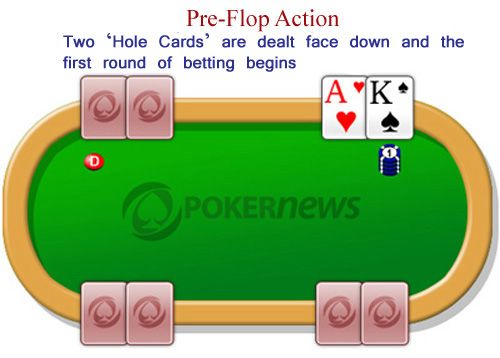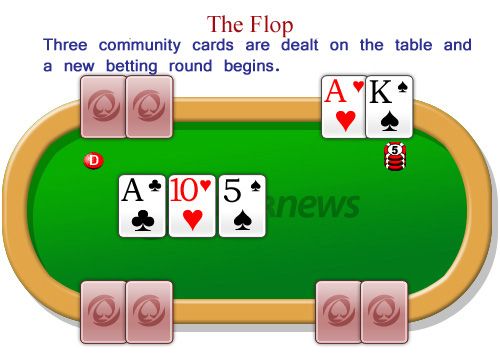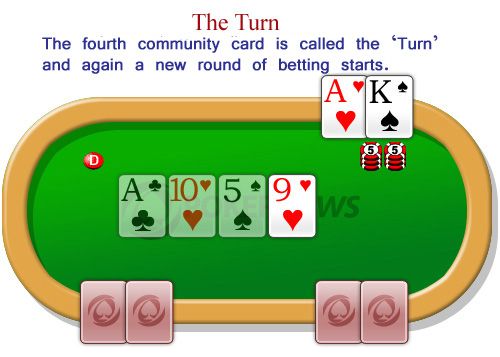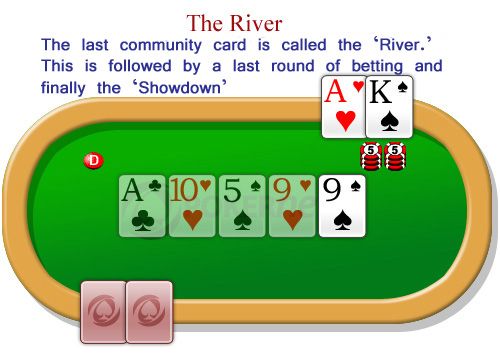Texas Hold’em Poker Rules P. 2
First Betting Round: Preflop

The first round of betting takes place right after each player has been dealt two hole cards. The first player to act is the player to the left of the big blind, a position referred to as “under the gun” because the player has to act first. This player has three options:
- Call: match the amount of the big blind
- Raise: increase the bet within the specific limits of the game
- Fold: throw the hand away
If the player chooses to fold, he or she is no longer eligible to win the current hand.
The amount a player can raise to depends on the game that is being played. Most commonly in a game of no-limit Texas hold’em, the minimum opening raise must be at least twice the big blind, and the maximum raise can be all of the chips a player has in his or her stack (an “all-in” bet).
Best casino slots in 2023 USA

300% Welcome Bonus |

Choose 100% Bonus |

Take 100% Welcome Bonus |

100% free spins |
There are other betting variations in hold’em poker. In fixed-limit hold’em (or just “limit hold’em), a raise is always exactly twice the big blind. In pot-limit hold’em (played much less often than the other variations), players can bet anywhere from the amount of the big blind (the minimum bet allowed) up to the total amount in the current pot.
After the first player (“under the gun”) acts, play proceeds in a clockwise fashion around the table with each player also having the same three options — to call, to raise, or fold. Once the last bet is called and the action is “closed,” the preflop round is over and play moves on to the “flop.”
Second Betting Round: The Flop

After the first preflop betting round has been completed, the first three community cards are dealt and a second betting round follows involving only the players who have not folded already.
In this betting round (and subsequent ones), action starts with the first active player to the left of the button. Along with the options to bet, call, fold, or raise, a player now has the option to “check” if no betting action has occurred beforehand. A check simply means to pass the action to the next player in the hand.
Again betting continues until the last bet or raise has been called (which closes the action). It also can happen that every player simply chooses not to be and checks around the table, which also ends the betting round.
Third Betting Round: The Turn

The fourth community card, called the turn, is dealt face up following all betting action on the flop. Once this has been completed, another round of betting occurs, similar to that on the previous street of play. Again players have the option to options to check, bet, call, fold, or raise.
Final Betting Round: The River

The fifth community card, called the river, is dealt face up following all betting action on the turn. Once this has been completed, another round of betting occurs, similar to what took play on the previous street of play. Once more the remaining players have the option to options to check, bet, call, fold, or raise.
After all betting action has been completed, the remaining players in the hand with hole cards now expose their holdings to determine a winner. This is called the showdown.
The Showdown
The remaining players open their hole cards, and with the assistance of the dealer a winning hand is determined. The player with the best combination of five cards wins the pot according to traditional poker hand rankings. These hand rankings aren’t specifically part of Texas hold’em rules, but apply to many different poker games.
- Royal Flush — five cards of the same suit, ranked ace through ten; e.g., A♥K♥Q♥J♥10♥
- Straight Flush — five cards of the same suit and consecutively ranked; e.g., 9♣8♣7♣6♣5♣
- Four of a Kind — four cards of the same rank; e.g., Q♣Q♥Q♦Q♠4♦
- Full House — three cards of the same rank and two more cards of the same rank; e.g., J♣J♥J♠8♦8♥
- Flush — any five cards of the same suit; e.g., A♠J♠8♠5♠2♠
- Straight — any five cards consecutively ranked; e.g., Q♣J♦10♥9♠8♦
- Three of a Kind — three cards of the same rank; e.g., 8♣8♠8♦K♣4♥
- Two Pair — two cards of the same rank and two more cards of the same rank; e.g., A♠A♣J♦J♣7♠
- One Pair — two cards of the same rank; e.g., 10♥10♣9♥4♦2♦
- High Card — five unmatched cards; e.g., A♣J♦10♠5♣2♥ would be called “ace-high”
Remember, players construct their hands by choosing the five best cards from the seven available (their two hole cards and the five community cards).
For example, if the board is showing 9♣5♠K♦3♠A♥, a player with the two hole cards A♦9♠ would have two pair (aces and nines), and would lose to a player who has 9♦9♥ for three of a kind (three nines).
Learning hold’em poker begins with understanding how hands are dealt and the order of play as described above. Of course, learning Texas hold’em rules is just the beginning, as the next step is to learn strategy which involves understanding what constitutes good starting hand selection, the odds and probabilities associated with the game, the significance of position and getting to act last during those postflop betting rounds, and many other aspects of the game.
Best casino slots in 2023 USA

300% Welcome Bonus |

Choose 100% Bonus |

Take 100% Welcome Bonus |

100% free spins |